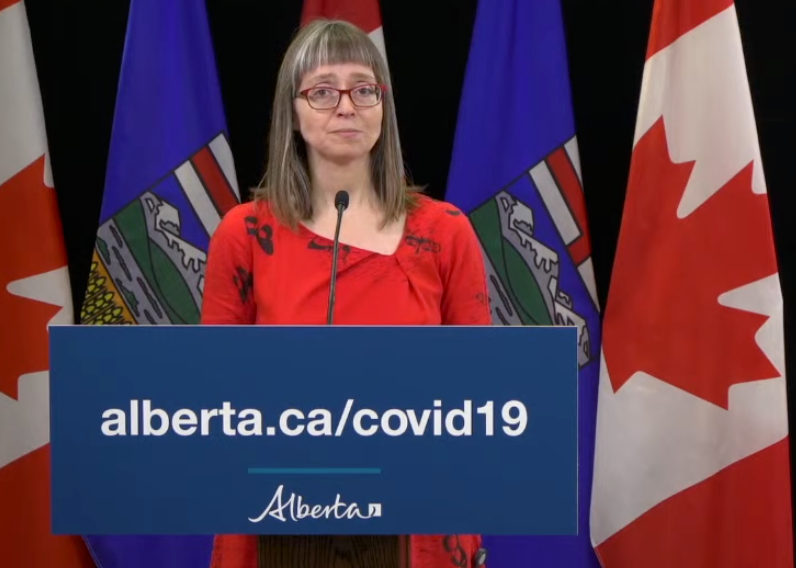ALBERTA – An additional five COVID-19 related deaths have been recorded in Alberta.
The province's Chief Medical Officer of Health Dr. Deena Hinshaw reported 29 new cases of the virus Monday (March 30) bringing the total number of diagnosed cases in Alberta to 690 as of Monday (March 30). Of those who have tested positive for COVID-19, 65 are suspected to be a result of community transmission.
A total of eight people have died and 94 people have fully recovered.
“This has been one of the hardest days yet,” Hinshaw said.
“These deaths speak to the seriousness of the COVID-19 pandemic and why aggressive measures from all of us are needed to contain the spread.”
The Canmore region has reported eight cases of COVID-19 and one case has been reported in the Banff region.
“The Town of Banff is aware of the situation, and credits the excellent work of Alberta Health Services for identifying the case and taking necessary steps to control the spread of the virus and ensure the individual receives the care they require,” said Silvio Adamo, director of emergency management for the Town of Banff and its emergency coordination centre, in a statement.
“The identity of the individual, their location or the nature of their presence in Banff is being kept confidential. We would publicise this personal information only if Alberta Health Services requires assistance with contact tracing.”
The recorded deaths include a Calgary woman in her 70s, a Calgary woman in her 50s, two Edmonton men in their 80s and a male in his 30s in the North zone.
“We have always known that with a rise in cases we will have more severe cases, just as a percentage, and with that comes deaths,” Hinshaw said.
There have been outbreaks in seniors facilities, she added, and this is concerning given the people vulnerable to COVID-19 in these centres. Hinshaw added these situations are being monitored closely and they are working hard to contain the virus to prevent further cases and deaths.
“Following the public health guidance will save lives,” Hinshaw said.
“We must re-double our efforts to protect those who are most vulnerable to the effects of this virus.”
Hinshaw noted that a new testing protocol has been introduced in Alberta and that it will take several days to get enough data to understand trends and the level of risk in the province.
She said the coming week will be critical in containing the spread of the virus and the switch in testing will focus on understanding where local transmission is occurring, how it can be prevented and how effectively public measures are working.
She added the province is working to release modelling data on the spread of COVID-19 by the end of the week. Based on the community transmission cases that have been diagnosed, it is estimated that there is an average of two cases for every one that has been confirmed.
“We will never be able to test every Albertan who has symptoms,” Hinshaw said.
“We need everyone to pitch in and do the right thing. Stay home if you are sick.”
Hinshaw, along with her counterparts from other provinces and territories, is part ofa special advisory committee on the response to COVID-19. She said during a recent phone conference it was decided that anyone who is in self-isolation or quarantined is now required to stay on their property for the full 14-day period.
This change includes everyone under mandatory self-isolation – both those who feel well and those who are displaying symptoms that include a cough, fever, shortness of breath, runny nose, or a sore throat.
“I know this is incredibly difficult – staying indoors or close to home for 14 days is a very long time,” Hinshaw said. “This is what we must do to protect each other.”
Hinshaw warned that anyone who is thinking of leaving where they normally live to smaller communities to weather the virus will be putting others in danger.
She said that if someone leaves an urban centre to go to a more rural setting there are fewer services available, this includes health care access and intensive care beds. An increased population also poses the risk of overwhelming the infrastructure in more rural centres, she said.
Hinshaw said it is also important to consider that making a move from an urban to a rural setting runs the risk of infecting others with COVID-19 if they are coming from areas that have experienced local transmission.
“If they’re leaving from a place like Edmonton or Calgary and going somewhere up north the risk they might inadvertently being incubating that virus and take it with them and infect a small community the consequences would be catastrophic,” Hinshaw said. “In this time the best thing we can do is stay close to home.”
Follow RMOToday.com's COVID-19 special section for the latest local and national news on the coronavirus pandemic, as well as resources, FAQs and more.





